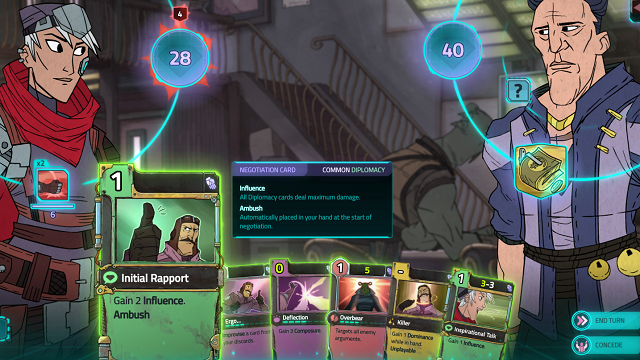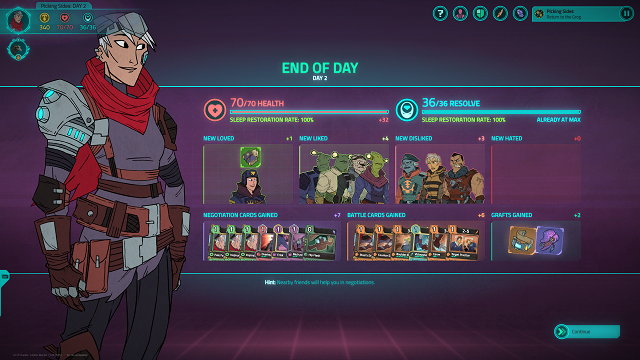Griftlands, despite launching in an incomplete Alpha state, is the most complete deck-building rogue-like I’ve ever played. Hyperbole aside, it has so much promise and quality that it’s difficult to know where to start.
As an avid slinger of cardboard, deck-building games are my forte. The genre’s bar has already been set incredibly high by the class of Slay the Spire and Steamworld Quest, but Griftlands has more than a few Aces up its sleeves.
Most notable and defining is the duality of negotiation and combat present here. You have two decks to build: one that’s used to persuade, threaten, and cajole your way through sticky situations, and a classic battle deck for when words won’t work.
You’re generally given good opportunity to choose whether to be a wordsmith or a warrior, which gives you the freedom to build an experience unique to you. The main exceptions to this are the ‘boss battles’; the story is currently split into 5 days, each ending with a particularly tough battle. Some training is required to survive them, so avoiding combat entirely isn’t advisable.

Improving your deck is unique and gratifying, though; both your negotiation cards and battle cards can be upgraded after repeated use. For instance, playing a basic Stab card six times will let you choose from two upgraded versions of that card. They won’t always be the same upgrades either, with some randomization thrown in for good measure.
The other significant difference between Griftlands and other deck-builders is that its gameplay loop is largely narrative-driven, with already rich lore to delve into if you desire. It’s very easy to assimilate, too, with various names, species, and jargon providing special links that bring up detailed tooltips when hovered over, much like Wikipedia articles.
It meets a nice balance between not forcing you to sit through needless exposition while being interesting enough that you don’t want to skip past everything. Many quests also require more than cursory attention to follow their throughlines, and consequences in Griftlands can be severely punishing. This makes it thoroughly engaging on its own, whereas other rogue-likes almost function better as a ‘second screen’ game.

It’s also thoroughly gorgeous to look at, too, with a stylized art style that’s clean, crisp, and captivating. I especially love the summaries, which condense a large amount of information into one easy-to-peruse screen. The cards also have simplistic visuals but show real depth with rarity and upgrade status subtly sewn in.
Despite the strong narrative, Griftlands stays loyal to many of the usual idiosyncrasies that make a rogue-like. Randomization is woven throughout the game’s quests, and even when moving between them on the over-world map, there’s a number of random triggers that can help or hinder you.
As a direct result, it presents a good challenge throughout; even when everything goes your way, it won’t be a cakewalk! The easy way out always has repercussions, and siding with the wrong person can scupper your entire run.
The story itself doesn’t dictate a linear campaign, either. You can replay runs with entirely different results and decks if you fail, and a successful run doesn’t mean you’re done. Regardless of how the run ends, you’re given a summary screen of your actions, which awards you with XP.

This, in turn, unlocks new packs of cards that can be found in future runs, providing some meaningful progression. Permanent progression systems like this make it feel like your time has greater intrinsic value in roguelikes, so it’s great to see it here.
It’s far from perfect, of course; as it is only an Alpha release, there are areas lacking typical polish such as bugs, spelling mistakes, and the like. There’s also a large quantity of content still in development; the final game will include three playable stories, while the alpha release only features 80% of one character’s story.
It’s also missing difficulty options and other customization options that are planned for the future, but with a fortnightly release schedule, we can expect updates to bring new content thick and fast.
The feedback system is also built straight into the game, which I love. Pressing “F8” at any time will let you send feedback to the developers, positive or negative, along with a screenshot and your save data for them to debug.

We won’t put a final score on our impressions just yet, as it is only an alpha, and there’s an estimated year of Early Access patches to come before the title gets a 1.0 release. But it’s on sale now for $15 on the Epic Store, and it’s easily worth that in its current state, alone.
Hopefully, Klei will takes this bold start and snowballs it into the best, most robust deck-builder of all time. Griftlands certainly has the potential for it.
For more on Griftlands, check out our detailed guide breaking down the Negotiation system that makes it so special.







Published: Jul 17, 2019 05:45 pm